Lamprocapnos spectabilis, formerly Dicentra spectabilis
In the world of garden plants, few stick out as immediately identifiable as Lamprocapnos spectabilis, commonly referred to as bleeding hearts.
I remember these flowers from my youth, as I’m sure many other gardeners do.
It took a long time for me to grow and tend for my own, but I’ve since wasted no effort fostering these springtime lovelies since they’ve found their way into my gardens.

We link to vendors to help you find relevant products. If you buy from one of our links, we may earn a commission.
In time I came to appreciate their ease of maintenance as much as their soothing foliage and drip-dropping flowers.
Let’s learn about where these plants came from, and why they deserve a spot in your garden.
What You’ll Learn
What Are Bleeding Hearts?
Often referred to as “old fashioned bleeding hearts,” these herbaceous perennials are members of the poppy family, Papaveraceae.
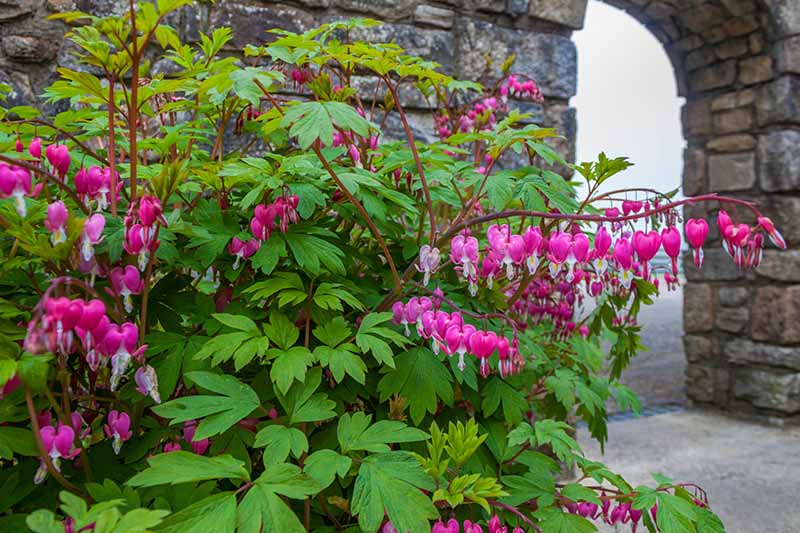
Soft, green, fern-like foliage and stems support the iconic heart-shaped flower petals, complete with a tiny, trailing drop of color at the bottom of each flower.
It’s impossible not to see where this beauty gets its common name!
They bloom in mid-to-late spring to early summer, and die back over the hotter months, reappearing in all their splendor next season.
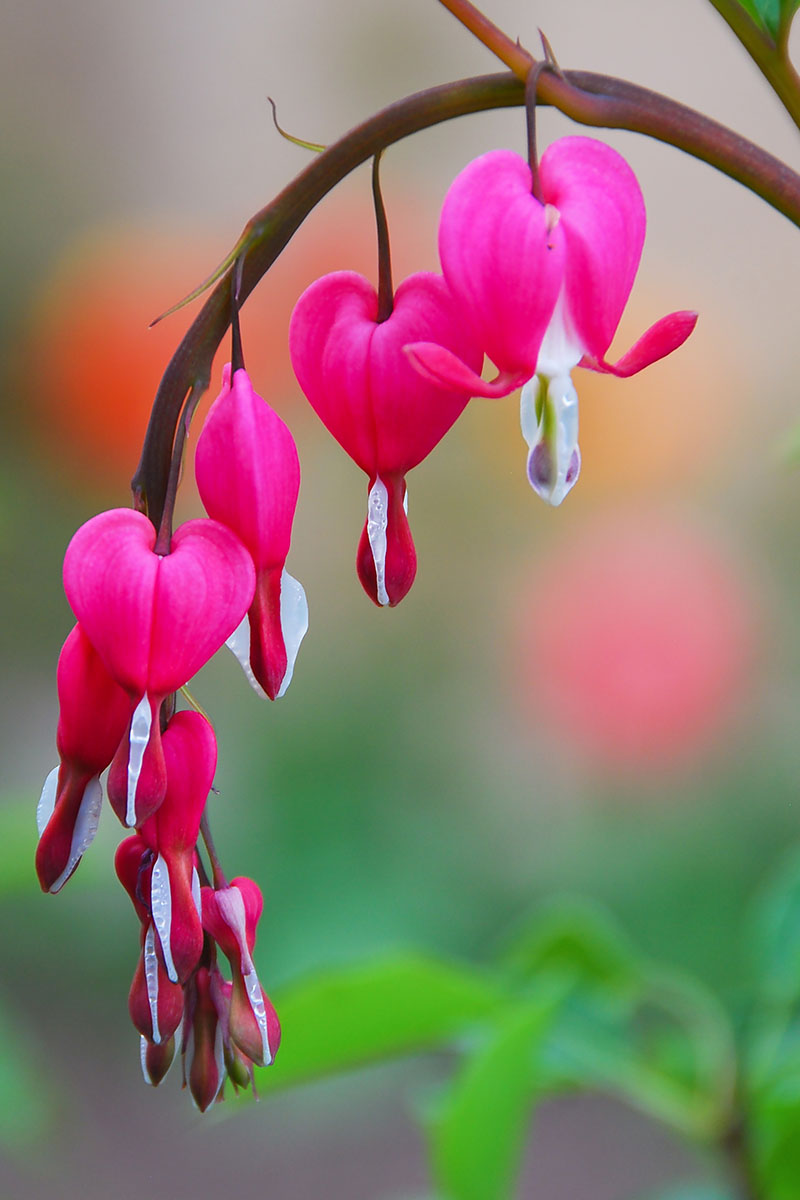
Bleeding hearts will thrive in USDA Hardiness Zones 3 to 9, bloom times may vary.
They are easy plants to care for, but require a skilled and artful eye to compensate for the the gap they leave in borders and beds after they’ve finished blooming.
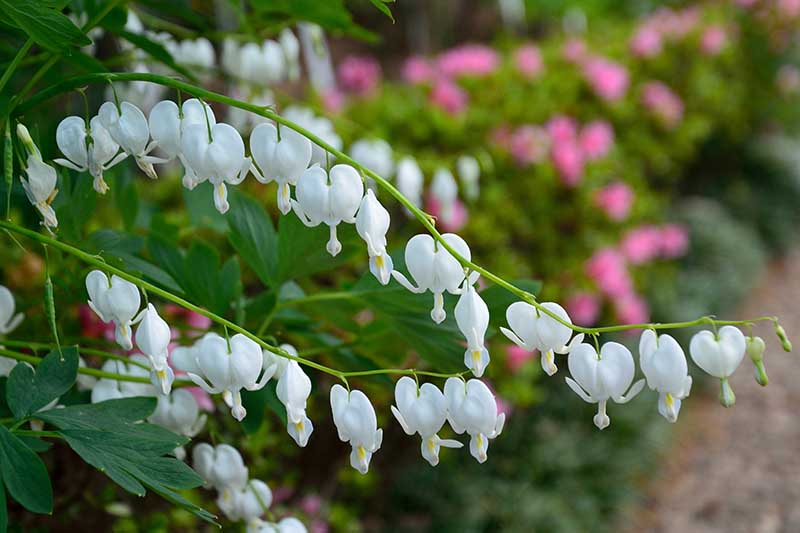
Formerly known as Dicentra spectabilis, and indeed still referred to by this name by many nurseries, in 1997 the plant was reclassified as Lamprocapnos spectabilis.
According to an article published in 1997 in the Journal of Plant Systematics and Evolution by Magnus Linden et al, DNA testing revealed that the bleeding heart is actually more closely related to other members of the Lamprocapnos genus than those of Dicentra.
In 2006, the Royal Horticultural Society recognized the name change, and lists D. spectabilis as a synonym.
Cultivation and History
Originally from Asia, bleeding hearts made their way into Western gardens in the mid-nineteenth century.
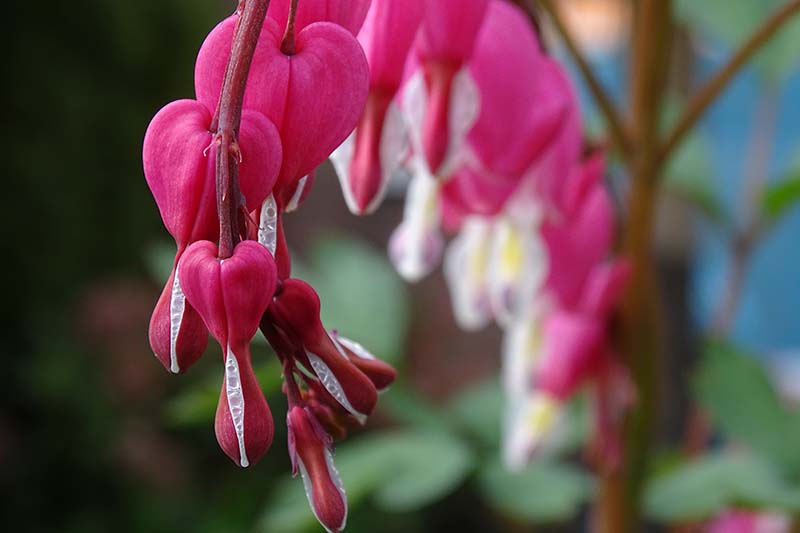
Since then, they have become a familiar feature in many European and North American gardens.
Although not native to the United States or Europe, L. spectabilis is not considered invasive in these regions because of its brief bloom cycle and tendency to grow slowly in a contained area.
Bleeding Heart Plant Propagation
While it is possible to grow L. spectabilis from seed, this isn’t usually recommended.
It does not transplant well after emerging as a seedling, and it can be difficult to get these seeds to germinate in the first place.
From Seed
If you’re a glutton for extra work, you can purchase seeds and start them indoors about 12 weeks before your average last frost date.
You’ll need to cold stratify them first, by placing the seeds in the refrigerator for four to six weeks before sowing. And be patient – it can take up to a month for them to germinate.
Keep the seedlings in full light and follow the basic rules of growing seedlings: rotate your plants so they don’t grow lopsided, don’t water too much, and plant extra because you’re probably going to lose some along the way.
Timing the transition from seed tray to garden can be difficult because L. spectabilis does not transplant easily, and an unexpected cold snap could ruin all of your planning and preparation.
When they have grown two sets of true leaves, plant out the seedlings in a shady or part-shade area of your garden and keep an eye on just where they’re planted.
Alternatively, you can sow seeds directly after harvesting them from an existing plant. Wait until the seed pods are completely dry, and sow them an inch deep.
From Division or Transplants
The easiest way to propagate bleeding hearts is through simple root division, or to purchase live plants that are ready for transplant.
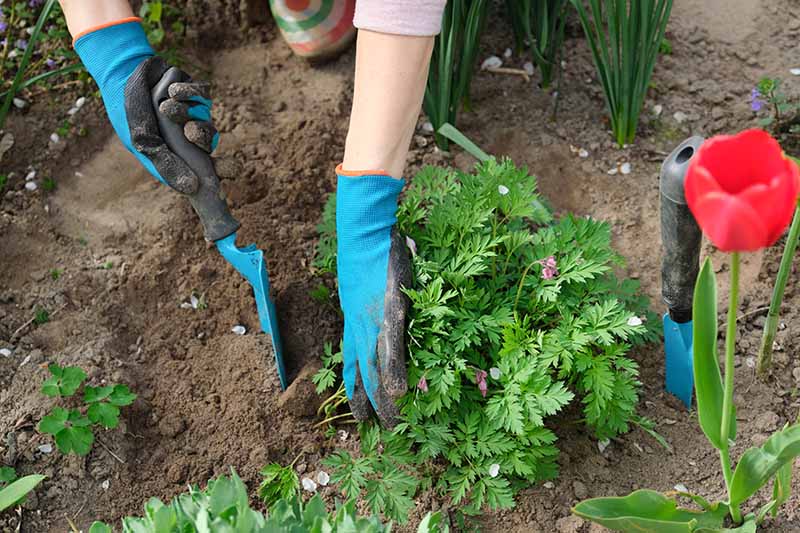
Because the plant grows thick, rhizomatous roots, dividing it is an easy process with a high success rate. Follow our guide to dividing perennials to learn how.
You can divide your plants in fall, after they have been dormant through the summer months, or in spring when new growth starts to appear.
Place your transplants one to two feet apart in soil amended with compost, and place the transplanted L. spectabilis in an area you can easily check regularly.
Keep them watered, but not too wet. I like to give the plants a heavy drink right off the bat when they are first transplanted, and another deep drink by the end of the first week. Then keep an eye on them for the following weeks until they’re established.
You can also obtain dormant bare-root plants from nurseries, for planting out in spring.
Find more tips on propagating bleeding heart flowers here.
How to Grow Bleeding Heart Flowers
This will sound ridiculously simple, but that’s one of the beautiful traits of L. spectabilis. It’s a remarkably easy shade ornamental to grow.
Apart from a few minor pests to contend with, it’s hardy and requires a modicum of care and attention after planting.
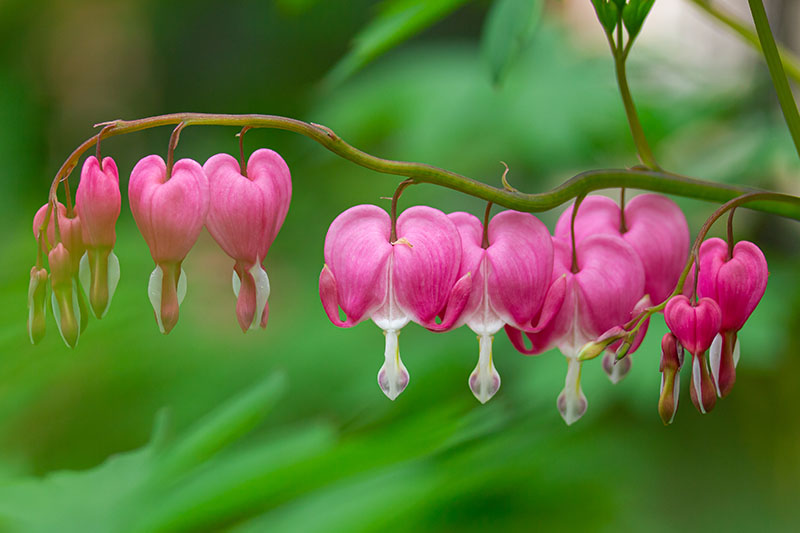
It grows best in well-draining soil that’s moist and rich in organic matter, such as leaf mold or compost.
Avoid planting in areas where the soil is prone to drying out. A pH of 6.0 to 7.0 is ideal, as soil that is too alkaline can cause yellowing foliage.
In its native environment, bleeding hearts grow in a woodland setting, so aim to mimic that soil – rich in organic matter with consistent moisture.
Besides following the standard order of operations for planting a new addition to your garden, caring for bleeding hearts only requires meeting a few basic needs to keep it happy and full of life.
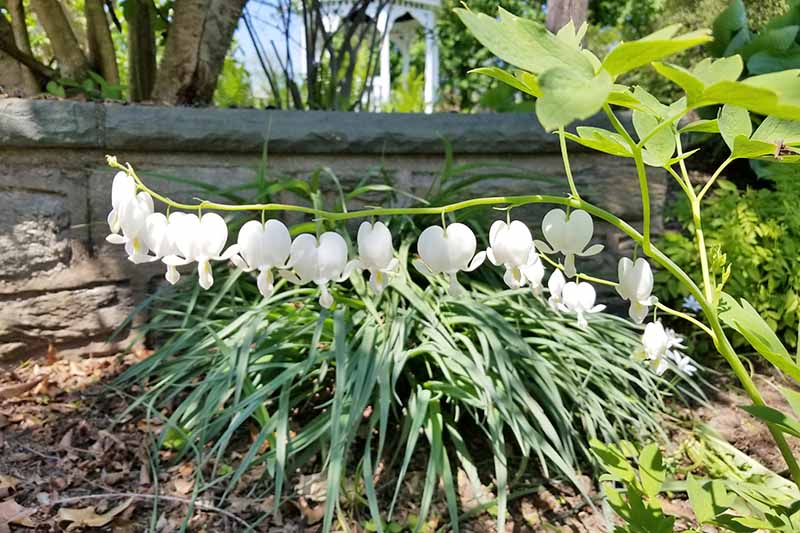
As in real estate, the key to happiness here is location, location, location.
Bleeding hearts mostly prefer shade or part-shade locations.
If it’s not an overly sunny (southwest) area of a yard, I’ve seen plants receive as much as eight hours of sun a day and still produce bountiful flowers.

However, this is an exception, as this plant strongly prefers at least some shade during the day as a reprieve from the heat and sun. Sounds like me.
Regular moisture levels in the soil are an important factor in the health of the plant, but it’s easy to overdo it.
While many companions in your garden require an inch of rain a week, including L. spectabilis, your bleeding hearts don’t want to dry out either.
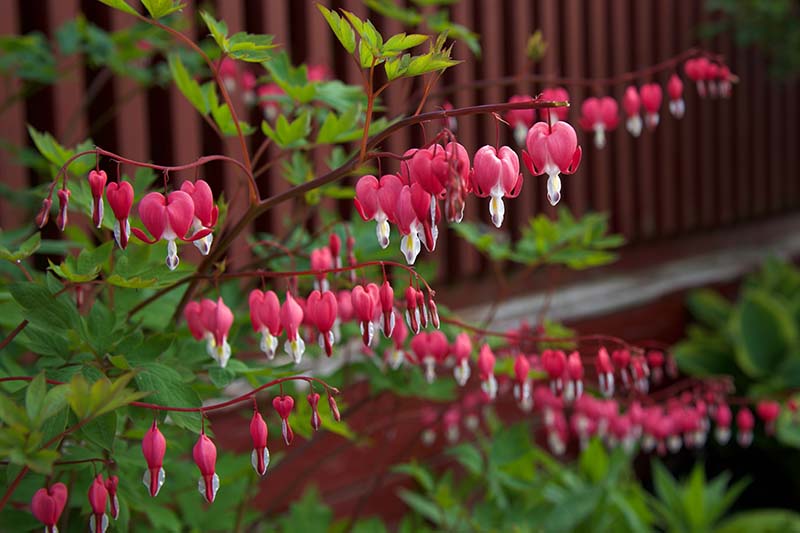
They require a consistent level of moisture in the soil, and while they never wants it sopping wet, they can’t tolerate dry periods either.
This is why a shady location works best, and your plants will need additional irrigation during dry spells.
This plant is buddy-buddy with ferns, astilbe, and hellebores, so aim to mimic these cool and evenly-moist conditions that they enjoy as best you can.
In fact, the toughest part of growing L. spectabilis is finding the right companion plants for this nigh-ephemeral perennial.
It loses its foliage quickly as the summer heat sets in, and can leave a noticeable gap in the garden once it goes bye-bye.
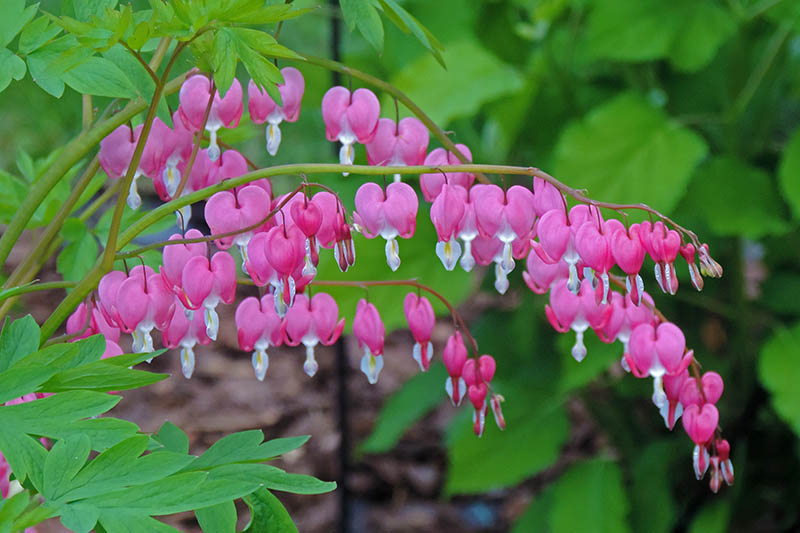
Except for stones and natural pieces of the landscape, I’ve never liked ornamentation in a garden.
Sorry, I just can’t do it! But many of my clients love this type of art and craft, so I may position a bird bath, metal wire sculpture, or (at one house) even an (ugly) garden gnome near to the bleeding hearts.
When the foliage dies back and is removed, these decorations can take precedence in that now empty space.
I think that gnome’s name is Winklebottom. He’s alright, for a gnome.
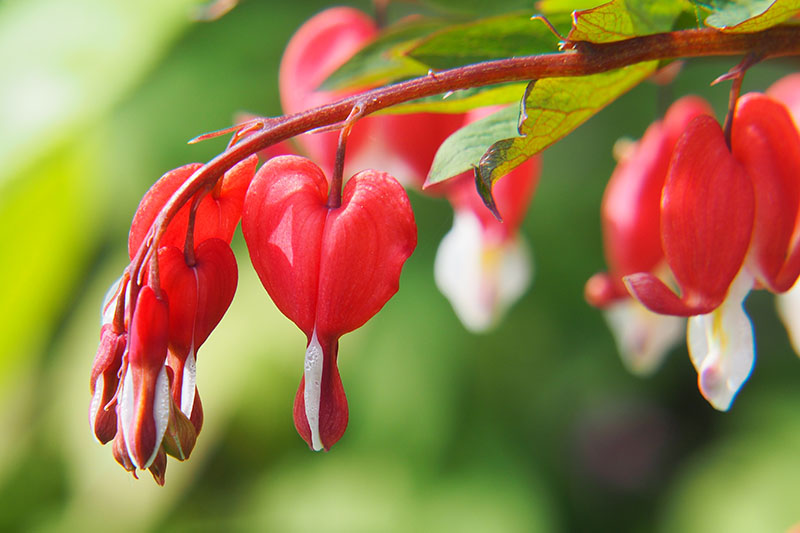
The best selection to compensate for the inevitable empty spot where bleeding hearts once stood is to find a companion plant that appreciates the room to grow just as L. spectabilis is dying back.
If you’re looking for something taller to fill the gap, consider a bed of ferns, anemone, or annual plants like impatiens and begonias.
On the shorter side of the scale, I like to pair bleeding hearts with ginger, painted ferns, heuchera (because they’re impervious and lovely all at once), and hellebores.
Growing Tips
- Keep your bleeding hearts in the Goldilocks Zone of water – not too wet and not too dry.
- Plant in shade or part-shade in moist, organically rich, well-draining soil.
- For growing in pots, consult our bleeding hearts container care guide.
- If your bleeding hearts refuse to flower, consult this guide for troubleshooting tips.
- Find companion plants that come up and are at their peak after bleeding hearts lose the last of their brittle foliage.
- These are cold hardy plants, but these tips can help them get through winter.
Pruning and Maintenance
Have you provided enough shade and the appropriate amount of moisture for your bleeding hearts?
Good, that’s about all you gotta do.
Besides this very basic lesson of “location, location, location,” you’ll need to cut your L. spectabilis back when it’s finished flowering.
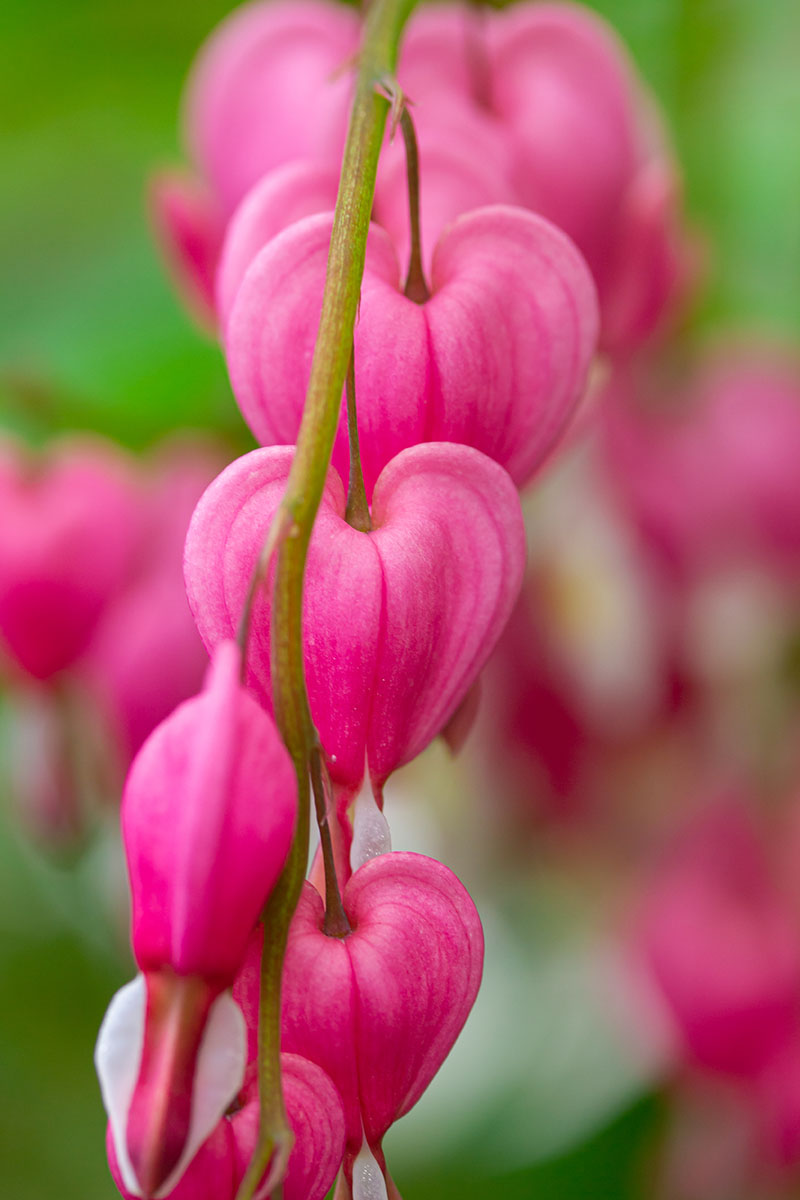
The foliage and stems should start to dry up and get all sorts of crispy by July. It’s not inappropriate to cut the foliage back a little sooner, and likewise to leave it standing for much longer.
In the right gardens – I’m thinking woodland settings – I like to leave the foliage of my bleeding hearts up for as long as possible.
I understand that allowing dead plant matter to accumulate can create a breeding ground for disease and bacteria. But I figure these plants got along just fine without an attentive gardener for thousands of years. They know what they’re doing, right?
It’s up to you whether you want to cut back the foliage when it dies, or leave it alone.
Bleeding Heart Cultivars to Select
The most popular and well-loved variety is the old fashioned bleeding heart.
There are a few different cultivars of L. spectabilis available, and more from the – now unrelated – Dicentra genus, that may be listed as “bleeding heart” by some nurseries.
Alba
‘Alba’ is a fast-growing variety with lime green foliage and elegant white flowers, with the characteristic droplet at the bottom of each bloom.
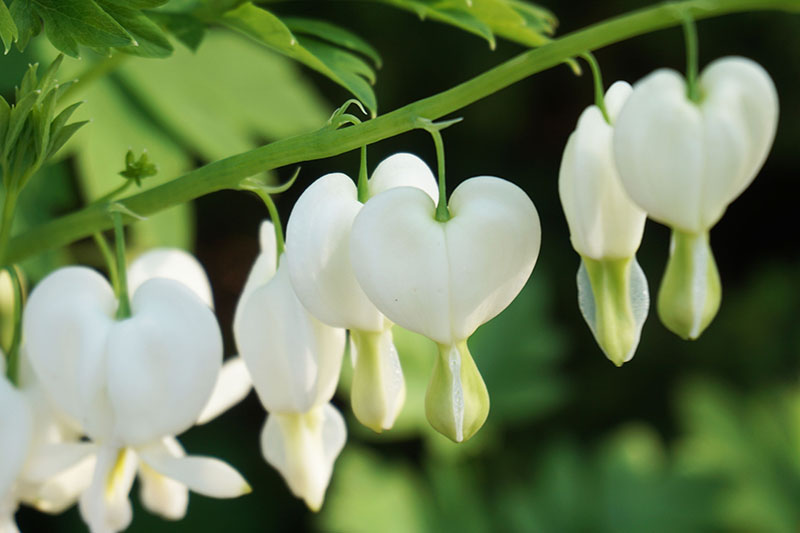
It blooms on arching stems for six to eight weeks in mid- to late spring, and looks heavenly planted among the more traditional pink variety.
‘Alba’ grows 24 to 30 inches tall at maturity, and its clumping form can spread 18 to 36 inches.
You can find bare root plants for these timeless classics available at Home Depot.
Common, or Old Fashioned Bleeding Heart
The most popular, original bleeding heart, L. spectabilis will provide a delightful pop of pink color, and add texture with its showy blooms to any shady spot in your yard.
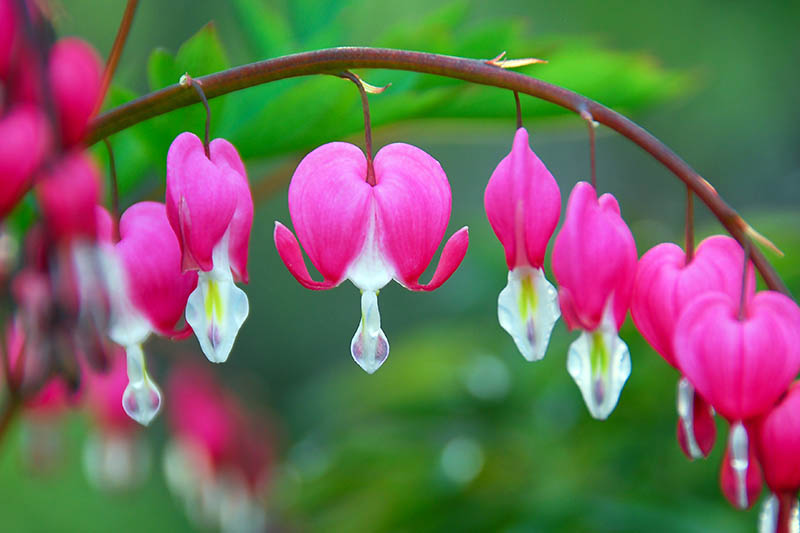
The arching stems drip with pink hearts with a snowy white tip.
The old fashioned bleeding heart grows up to 30 to 36 inches tall at maturity.
You can find two- to four-year-old plants in half-gallon containers from Nature Hills Nursery.
Alternatively, you can find bare roots that will ship in the spring, ready to plant, available at Eden Brothers.
Gold Heart
If the name of this cultivar conjures visions of gold hearts adorning your garden, you will be disappointed. It’s the foliage that is a yellowish-gold color.

Once the pretty pink flowers bloom amongst the yellow-gold foliage, you’ll find this cheery variety adds interest and texture, especially in areas already heavy with greenery.
‘Gold Heart’ has pink flowers that are identical to the common variety, and grow up to 30 to 36 inches tall at maturity.
If you prefer your golds to your greens, you can find roots for ‘Gold Heart’ available at Home Depot.
Valentine
Will your heart bleed this Valentine’s Day? Not for long, with this deep red version of the old fashioned favorite.
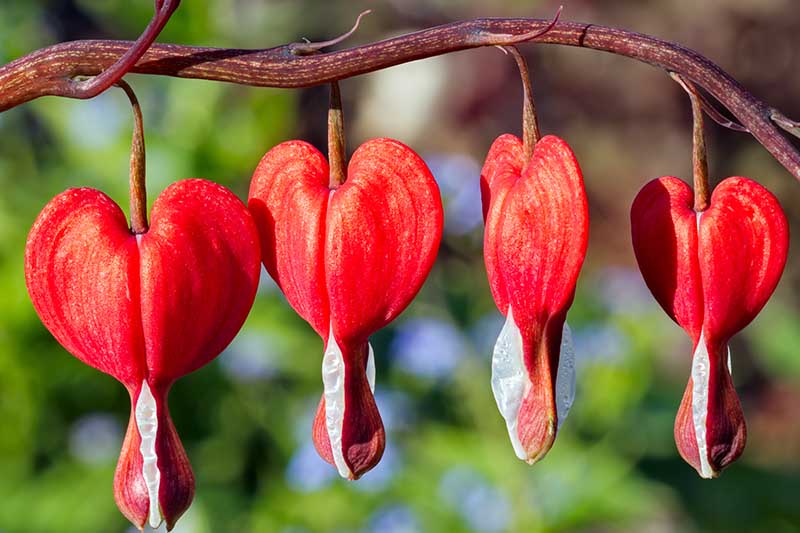
Elegant scarlet flowers adorn the arching, deep red stems.
More prosaically known as ‘Hordival’ by some nurseries, this cultivar is slightly smaller than the common variety, reaching a mature height of one to two feet tall.
You can find live bare root plants for ‘Valentine’ available at Walmart.
Managing Pests and Disease
On the whole, these plants don’t suffer from many problems with pests or disease. However, there are a few things to watch out for:
Herbivores
I live my gardening life by the motto “nothing is deer proof,” so I won’t say with 100 percent certainty that deer, rabbits, and other grazers are going to ignore L. spectabilis if nothing better is on the menu.
However, this plant is rarely of interest to grazing critters, and is more likely to sustain damage from a deer carelessly charging through the garden than to be subject to a quick nibble.
Insects
This plant is remarkably resistant to bothersome pests. I’ve yet to see any serious damage on any of the bleeding hearts I care for.
I attribute this to their innate resistance and also their relatively short active growth phase.
Aphids
Barely a concern, most aphid infestations will resolve themselves. You could use an insecticidal spray to alleviate your aphid problems, or buy some ladybugs and parasitic wasps to eliminate these sap-sucking insects.
Learn more about how to control aphids in your garden here.
Or take a page out of my book and let it be. Chances are that by the time you notice the yellowing leaves of your L. spectabilis and figure out it’s the work of aphids, you’ll be near the end of the growing season, at which point you can simply cut back the remaining foliage or ignore the bugs altogether.
Disease
Besides aphids, bleeding hearts can be plagued by a couple of diseases due to their ideal growing conditions being in wet, shady areas.
Fusarium Wilt
Fusarium wilt is a fungal disease that starts as a root-based problem, and works its way up to the tippy-top of the plant and leaves with telltale dark streaks on the stems. It can also cause damping off in seedlings and young plants. You can learn more about damping off here.
Verticillium Wilt
Verticillium wilt is also a fungal disease that causes problems in the vascular tissue of the stem, reducing water and nutrient uptake. Stems and foliage will wilt and then turn yellow, and eventually die off.
In both scenarios, your best solution is to simply remove and destroy the plant.
Avoid planting any other L. spectabilis plants in this location for at least a year to prevent a recurrence.
Find more tips on identifying and treating diseases of bleeding heart plants here.
Yellowing Leaves? It’s Not a Problem
Because bleeding hearts are such a short-lived perennial above ground, they tend to yellow and fade quickly.
I’ve seen them last through July but rarely into mid-August. If the foliage is yellowing but not presenting signs of the above fungi, you can simply ignore the condition of the plants.
They have a short season, and lose their green sooner than other plants in the garden.
We have more information on why bleeding heart leaves may turn yellow here.
Best Uses for Bleeding Heart Plants
I’ve got a garden full of ones and twos; that is, I have a garden full of singular specimen plants with little attention to mass plantings.
I like a kaleidoscope of color and interest, and I find incomparable joy in watching a sort of left-and-right-and-back-again season of interest.
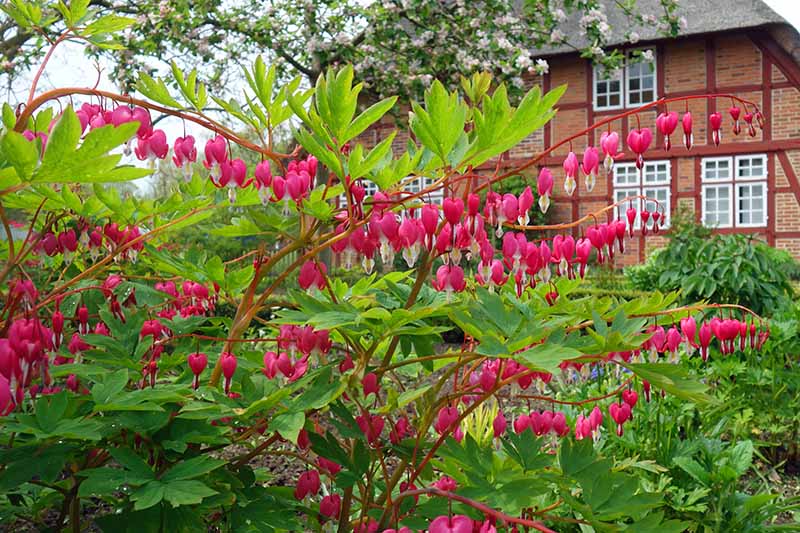
For that reason, I prefer to have bleeding hearts scattered around a growing area.
This allows random pops of heart-shaped flowers and color in the spring and early summer, ideally nestled beneath a large tree or in the undergrowth of shrubbery.
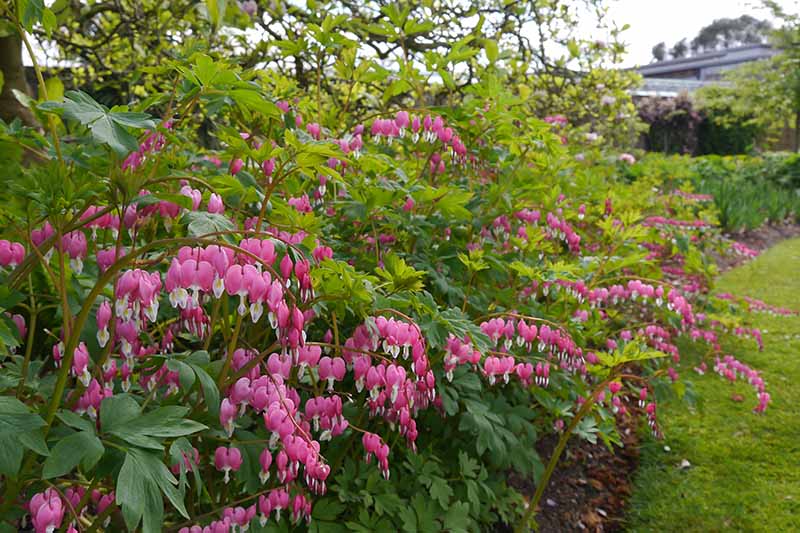
I let the plants grow and spread as they like until they start to grow unruly. At that point, I divide the plant and transplant some, or give others to my friends and neighbors.
But in some gardens where I work, the clients prefer more uniformity.
In that scenario, I suggest planting L. spectabilis in tight clumps surrounded by companion plants to fill in the gaps later in the summer. This is a perennial that works well en masse.
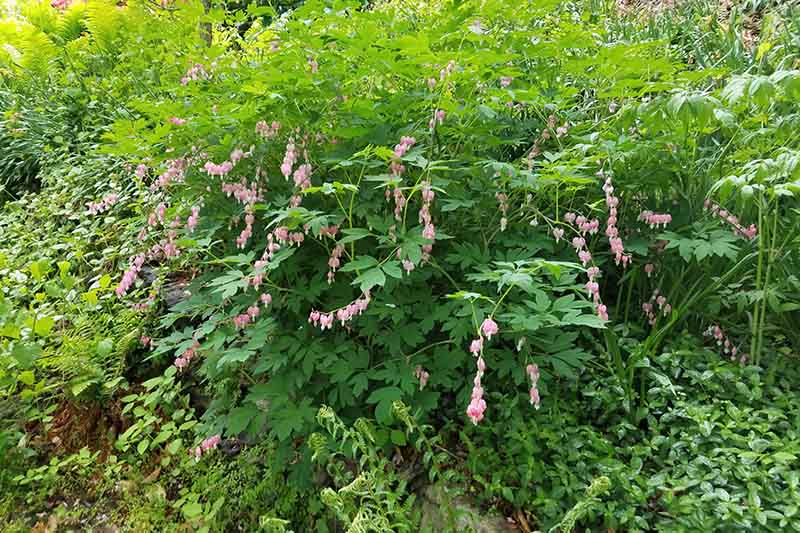
On the flip side, if you’re working with a more limited space, a single section dedicated to bleeding hearts will do the trick just fine.
They are a subtle and somehow still striking specimen to place in the garden.
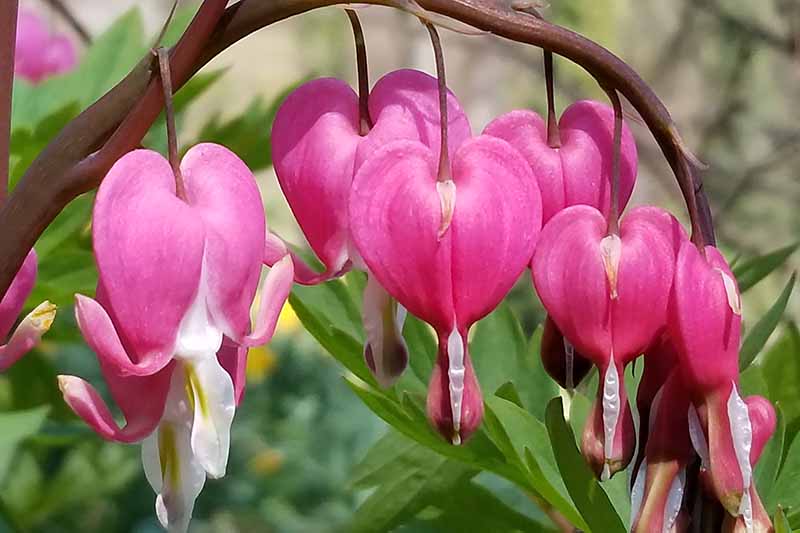
My aunt had three rhododendrons in her front yard spaced about three feet apart, and these lovely shrubs were hyphenated in between with bleeding hearts.
Some years the bloom season overlapped and others it didn’t, but the years when this show of blooms coincided were well worth it.
Quick Reference Growing Guide
| Plant Type: | Herbaceous perennial | Flower / Foliage Color: | Pink, red, white; green, yellow-gold |
| Native to: | Siberia, China, Korea, Japan | Maintenance: | Low |
| Hardiness (USDA Zone): | 3-9 | Tolerance: | Shade, deer, most pests |
| Season: | Spring and early summer | Water Needs: | Moist but not soggy |
| Exposure: | Shade to part sun | Soil Type: | Average |
| Time To Maturity: | 60 days | Soil pH: | 7.0 (neutral) |
| Spacing: | 12-24 inches | Soil Drainage: | Well-draining |
| Planting Depth: | 1 inch (seeds). depth of the root ball (transplants) | Companion Planting: | Astilbe, begonias, ferns, hellebore, impatiens, and spring bulbs |
| Height: | 1-3 feet | Uses: | Specimens, mass plantings, beds and borders |
| Spread: | 1-3 feet | Family: | Papaveraceae |
| Growth Rate: | Moderate | Genus: | Lamprocapnos |
| Pests & Diseases: | Aphids; wilt | Species: | spectabilis |
Be Still, My Bleeding Heart
Bleeding hearts are an old-timey plant and a garden favorite, with good cause.
Easy to care for, with unique flowers and soothing green (or gold!) foliage, they are all too happy to bloom and thrive in those shady areas that nothing pretty seems to like.
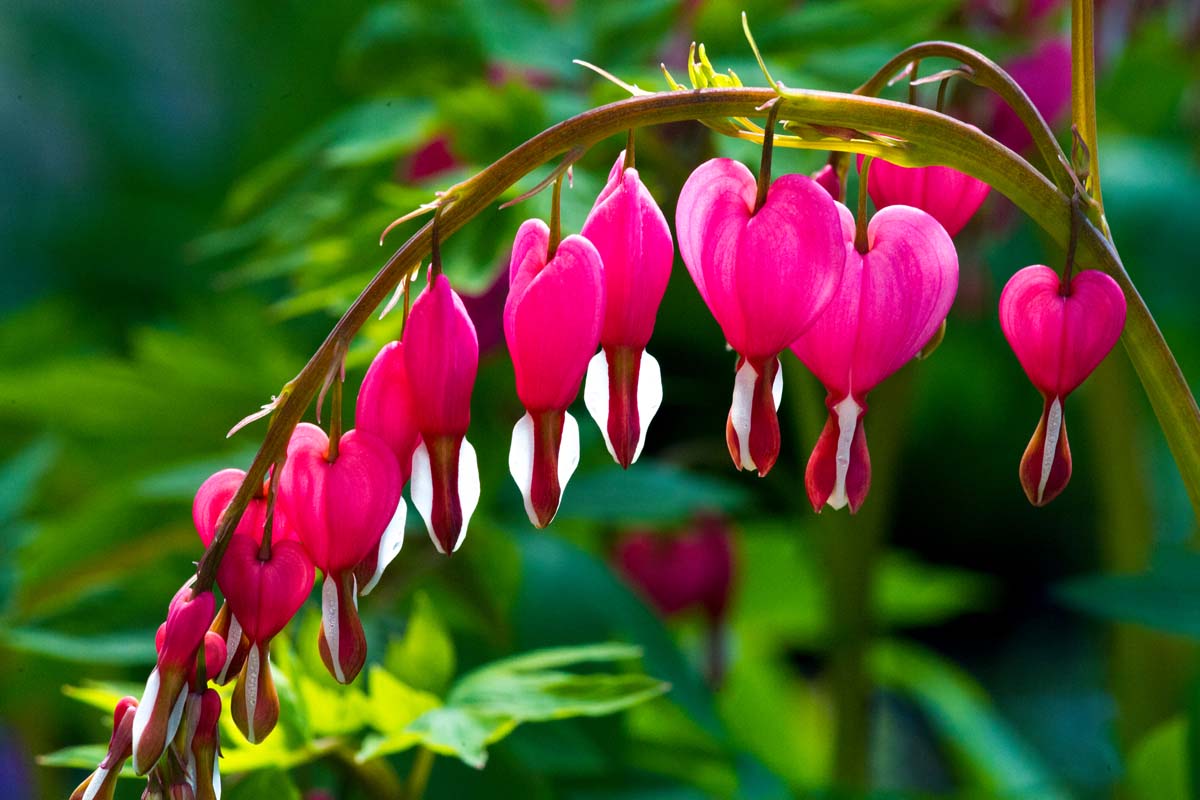
Toss out your worries and your concerns, and throw some bleeding hearts into your garden and watch them bloom, then tell us all about it! Feel free to leave us a comment below.
And if you are looking for more shade loving plants, why not try these guides next:
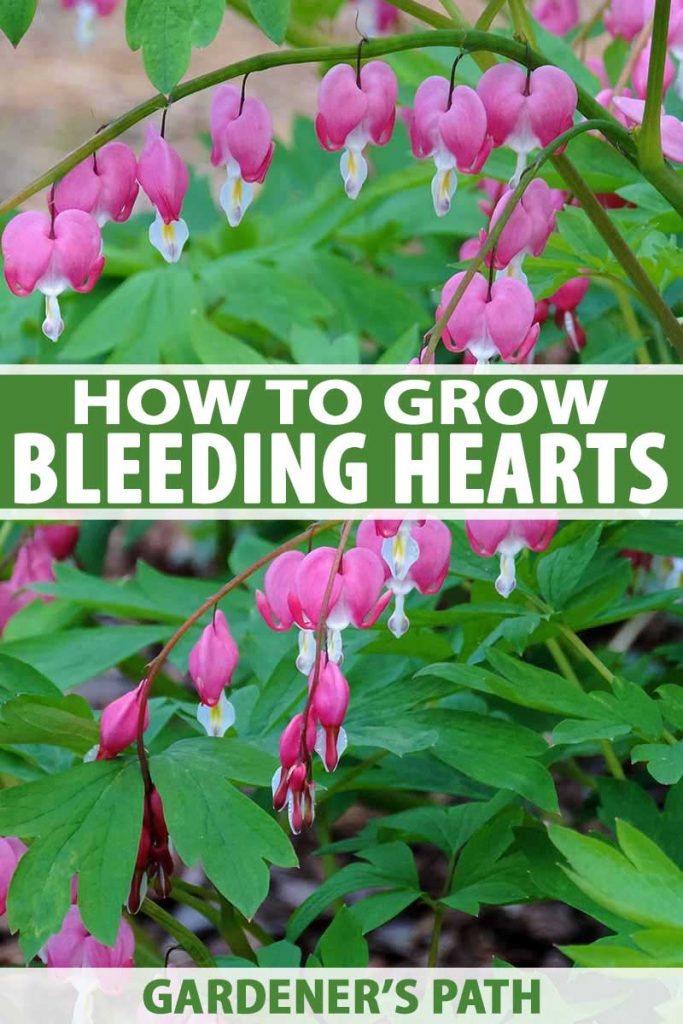
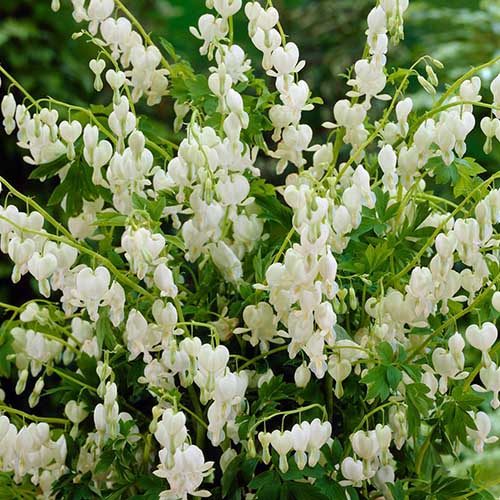
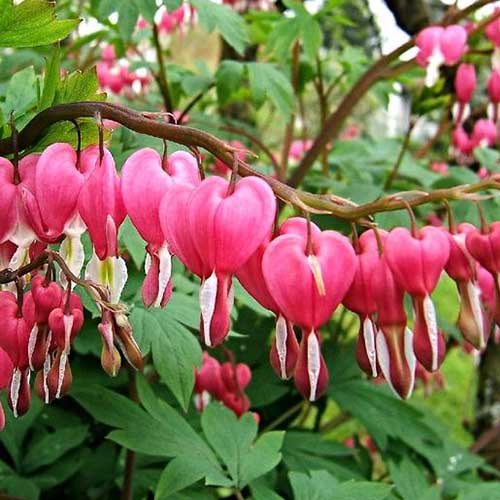
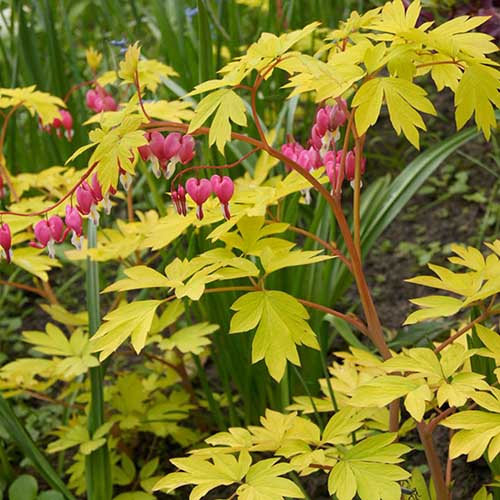
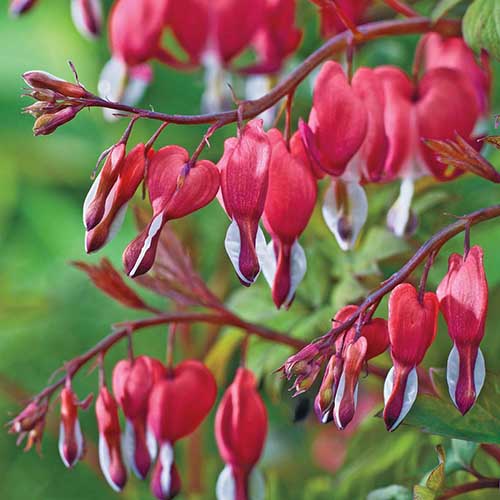
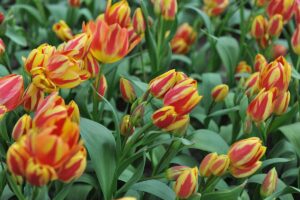
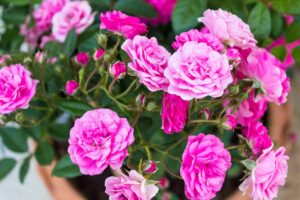

CAN I TRANPLANT SOME OF THE ROOTS AND WHEN IS THE BEST TIME?????
Yep, you can do a simple root division with bleeding hearts! It’s best to wait until the fall or the spring time though, since the stress of a summertime transplant can be a lot for any plant to handle.
My plant is in a flower pot on a balcony. In the shade it is beautiful and growing quite happily. Am I able to take it indoors when the weather turns? I live in Quebec where the weather turns snowy!
Hey Carole, you should be able to bring it inside over the winter but it can be a process to do it to the plant’s satisfaction. Most of the perennial plants we have in any environment need a winter period, a sort of dormancy where they can slow down their growth and catch some rest. Once springtime hits and the soil starts warming they can wake up and get ready for another year of bountiful blooms. Houseplants require this sort of dormancy too; that’s why it’s recommended not to water most houseplants more often than the bare minimum needed, because… Read more »
I’ve been trying to find this plant in Western Australia but have been unsuccessful so far. Do you know if they grown over here and if so who stocks them in the Perth area?
I’m growing them in Dublin, in pots. How should I feed them?
I have 2 old fashion bleeding heart plants & 2 that are suppose to be “everblooming,”. I have never divided them after many years, but they are appearing to be tired. Its still very cool this spring here in Michigan, but these plants are already a few inches high. Is this a good time to dig them up & divide. How close can I plant them to each other after diividing and will I know what to look for in regards to the eyes each transplant must have? This process is new to me.
Hi, this is my first year growing bleeding hearts, I wasn’t sure how big they got so I only bought one bare root. We are near the end of May now, southwest UK, and this is how big my plant got. Did I over crowd? It gets about 6 hours of morning sun, none after that as we have a massive tree behind that blocks all afternoon sun (and the fence)
It won’t let me upload a photo
Hi Charlotte, if you click on the paper clip at the bottom right of the frame it should allow you to select an image from your computer to upload. Let us know if you still have problems!
Hello I live in zone 10b (south Florida)
I want to plant these babies. Will they thrive here?
Hello Linais Jorge!
Sorry to say, I would not recommend bleeding hearts for south Florida. The hottest USDA hardiness zone where they’ll thrive is 9, and your part of Florida is hotter than that.
If it were another plant, I might risk it, but these need shade and even moisture, which is hard to maintain in Florida even for plants that are hardy there. Happily, there are lots of other beautiful perennials that do thrive in 10b, so I hope you’ll scan our site to find something more suitable. Happy gardening!
They are so pretty. Unfortunately it does not appear they would be suited to my garden in Queensland. Maybe in a shade house?
Hello Karon! I share your admiration for these flowers.
I’m assuming your garden has too much light, since they do grow in your Hardiness Zone, which I have down as 5 or 6, depending on what part of Queensland you live in?
If that’s the case, I imagine a shade house would be just the thing. Let us know how it goes if you do try bleeding hearts, okay? And thanks for reading.
I’m trying really hard to read this article, but instead I’m having to deal with the overload of ads!! ???? If your goal is money fr add more than writing informational articles, then so be it. Just don’t need it. I e accidentally hit the ad buttons over 5 times while trying to scroll down.
Thanks for the feedback, Sherrijean. We are a small business and ads help us to pay our writers, but you’re free to use an adblocker if it helps!